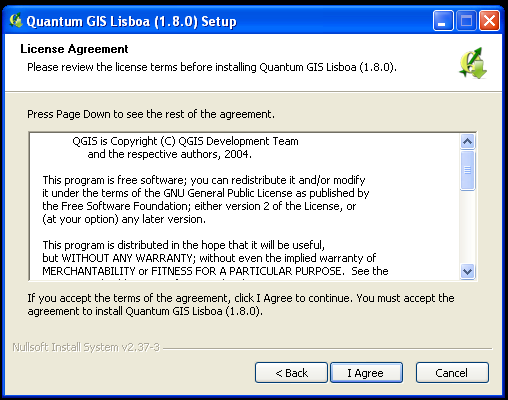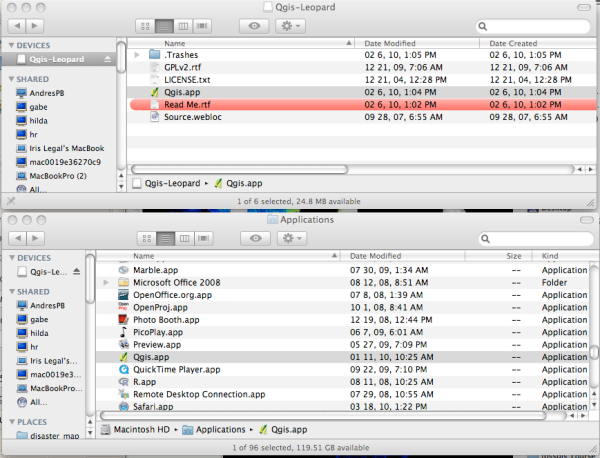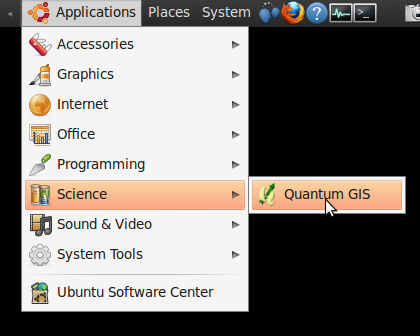Installing Quantum GIS¶
This guide walks through the installation of QGIS depending on your operating system.
Note
The current version of Quantum GIS available is QGIS 1.8.0 ‘Lisboa’. Download the installers from the QGIS download page.

MS Windows¶
Note
The screen-shots provided is the install process under Windows XP. It is assumed that you have administrative privilege in your system. The process is similar to later versions of Windows. However, there maybe occasions that you will be prompted to provide administrative account details. To run the installer as administrator, right-click the installer and choose Run as administrator.
1. Download the QGIS installer from the QGIS download page link given above.
2. Double-click the downloaded installer file. Click Next.

3. Accept the License Agreement by clicking I Agree.

4. You can choose where to install QGIS in your system by selecting the appropriate directory using the Browse button. Accept the default by hitting Next.

5. Aside from the main QGIS application, you have an option to download sample datasets, we will not use this data. Un-mark any of the optional sample datasets and click Install.

Installation will take a couple of minutes depending on your hardware specs.

6. Click Finish to complete your install process.

7. You can now start QGIS by hitting Start ‣ Programs ‣ Quantum GIS Lisboa ‣ Quantum GIS Desktop (1.8.0).


Mac OSX¶
1. Download the frameworks and installer from KyngChaos Qgis download page.
- GSL Framework
- GDAL Complete Framework
- QGIS 1.8.0 ‘Lisboa’ installer
Note
KyngChaos Qgis download page http://www.kyngchaos.com/software/qgis provides download for various Mac OS X versions. To get version information about your Mac, click Apple Icon > About This Mac.
2. Install all the required frameworks by double-clicking the downloaded .dmg files.
3. To install QGIS, double-click the downloaded “dmg”. A new finder window will open. Copy or drag the Qgis.app to your Applications folder

4. Launch QGIS by double-clicking the Qgis.app from your Applications directory
5. To remove QGIS, drag the Qgis.app from your Applications directory to the Trash icon in your Dock

GNU/Linux Ubuntu¶
Note
Command line instructions are outlined from hereon. It is assumed you know basic command line interface (CLI) and you have administrative privilege to install applications in your Ubuntu Linux machine. Depending on your Ubuntu version, installation may vary. The instructions below are for Ubuntu Precise 12.04 version.
1. Update your Ubuntu. Open Terminal and update all security updates:
sudo apt-get update
sudo apt-get upgrade
2. Install QGIS using the qgis.org repository. Open Terminal and edit your repository list:
nano /etc/apt/sources.list
3. Add the UbuntuGIS repository (replace the precise to your distribution version):
deb http://qgis.org/debian precise main
deb-src http://qgis.org/debian precise main
Save and close nano by typing Ctrl + x + s
4. To add the the qgis.org repository public key to your apt keyring, type:
gpg --keyserver keyserver.ubuntu.com --recv 997D3880
gpg --export --armor 997D3880 | sudo apt-key add -
This will now pull down the PPA’s key and add it to your system.
5. Install QGIS and the optional packages for Python and GRASS plugin:
sudo apt-get update
sudo apt-get install qgis qgis-common python-qgis qgis-plugin-grass
6. Start QGIS by hitting Applications ‣ Science ‣ Quantum GIS

7. To remove QGIS, open Terminal and remove the qgis application by typing:
sudo apt-get remove qgis
